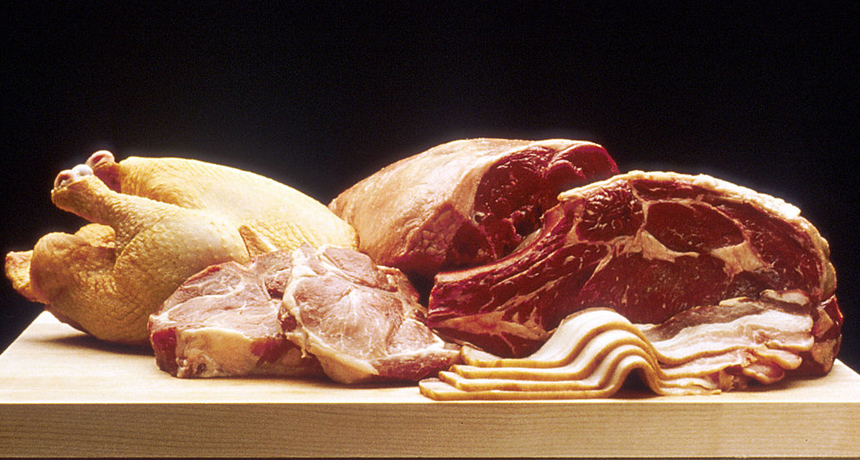Infected cutting boards
Kitchen cutting boards can spread dangerous germs to foods — and people

Bacteria from meat can contaminate the cutting boards used to prepare foods in the kitchen.
National Cancer Institute
Bacteria that have developed a resistance — immunity — to germ-killing antibiotics have become a serious health problem. People can die from the infections these germs cause. And some bacteria are resistant to not just one type of antibiotic but to many different ones. Infections caused by these multidrug-resistant germs are difficult to treat. Now, Swiss scientists have turned up a new way for these germs to spread: through kitchen cutting boards.
Handling cutting boards used to process meat or germy produce can contaminate clean hands, a Swiss study reports. The findings appear in the May issue of Infection Control and Hospital Epidemiology.
Most infections from multidrug-resistant germs occur in hospitals, notes Sarah Tschudin Sutter. She’s a doctor at University Hospital in Basel, Switzerland. Tschudin Sutter has tracked first-hand how these nasty germs spread in hospitals. But she also has treated infections that clearly started somewhere else. To probe one likely source, her team looked into food. Meats, actually.
The scientists began by examining cutting boards in the kitchen of the local hospital. There, cooks prepare food for hundreds of patients each day. The researchers used sterile cotton to swab 154 cutting boards that had been used to prepare food — before they were washed. The scientists noted the type of meat prepared on each surface (such as poultry, beef, pork, lamb or fish). They also collected gloves worn by the kitchen staff.
The scientists placed the cotton swabs and glove samples in a broth containing bacterial nutrients. This allowed any germs present to reproduce. Then the biologists used a technology called polymerase chain reaction, or PCR. It makes many copies of particular genes. Those copies can be used to identify different strains of bacteria.
Here’s what those analyses showed: Boards used to cut up poultry — and only poultry — were contaminated 6.5 percent of the time. One multidrug-resistant species was found: Escherichia coli. This E. coli is a well-known source of food poisoning. The multidrug-resistant germs also contaminated gloves worn when food was prepared. Half of the used gloves hosted those germs.
The team then expanded its testing. The researchers recruited 144 families in Switzerland, Germany and France. Their cutting boards were swabbed and PCR performed on the germs that turned up. As before, some cutting boards hosted E. coli — but only if they had been used to cut up poultry.
People probably wash their hands after handling raw meat, say the researchers. But cooks are less likely to wash again after handling the cutting board. And that means they can easily pick up potentially dangerous germs — and spread them — without knowing it.
The findings are important, says Gilberto Flores. A microbial ecologist at California State University, in Northridge, he was not part of the study. He says the new study points to yet another pathway through which drug-resistance genes can spread.
Why were drug-resistant germs only spread by poultry? Tschudin Sutter says that may reflect how chickens are slaughtered. Germs in the bird’s gut can contaminate the meat during processing. Other types of livestock are prepared differently. Those meats appear less likely to pick up germs, she says.
To prevent illness, Tschudin Sutter recommends washing hands often while preparing meals. Don’t just wash hands after handling raw foods (especially meat), she says. Wash again after handling any equipment — including cutting boards — that touched raw foods.
And while chicken is a common source of E. coli and other food-poisoning germs, it is far from the only one. Many people have been sickened by E. coli and other germs that hitchhiked into the kitchen on ground beef and salad greens. Some have even died.
Power Words
antibiotic A germ-killing substance prescribed as a medicine (or sometimes as a feed additive to promote the growth of livestock). Antibiotics may work against bacteria, fungi and some other germs, but not against viruses.
bacterium (pluralbacteria) A single-celled organism forming one of the three domains of life. These dwell nearly everywhere on Earth, from the bottom of the sea to inside animals.
E. coli (short for Escherichia coli) A bacterium that researchers often use to study genetics. Some types of this microbe cause disease, but many other forms of it do not.
immunity The ability of an organism to resist a particular infection or poison by producing and releasing special protective cells.
microbe Short formicroorganism. (see microorganism)
microorganism A living thing that is too small to see with the unaided eye, including bacteria, some fungi and many other organisms such as amoebas. Most consist of a single cell.
organism Any living thing, from elephants and plants to bacteria and other types of single-celled life.
polymerase chain reaction (PCR) A biochemical process that repeatedly copies a particular sequence of DNA.
resistance (as in drug resistance) The reduction in the effectiveness of a drug to cure a disease, usually a microbial infection.
strain (in biology) Organisms that belong to the same species that share some small but definable characteristics. For example, biologists breed certain strains of mice that may have a particular susceptibility to disease. Certain bacteria may develop one or more mutations that turn them into a strain that is immune to the ordinarily lethal effect of one or more drugs.







